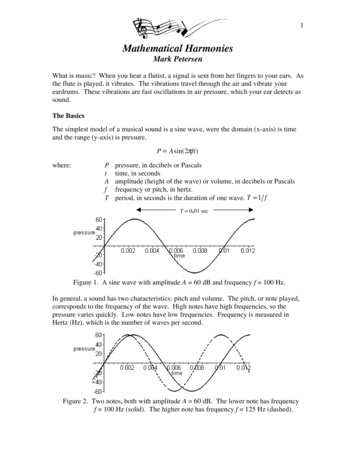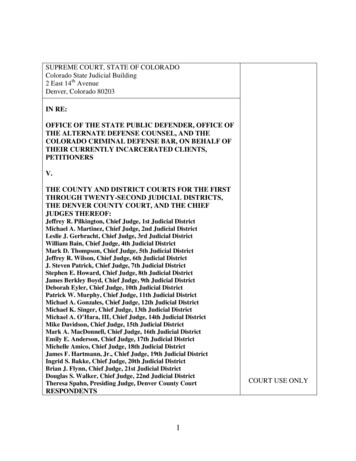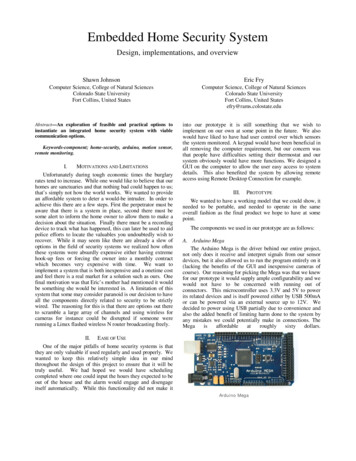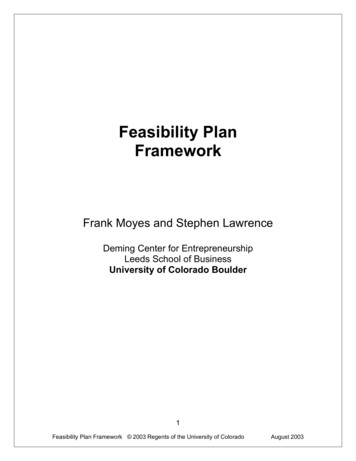
Transcription
1Mathematical HarmoniesMark PetersenWhat is music? When you hear a flutist, a signal is sent from her fingers to your ears. Asthe flute is played, it vibrates. The vibrations travel through the air and vibrate youreardrums. These vibrations are fast oscillations in air pressure, which your ear detects assound.The BasicsThe simplest model of a musical sound is a sine wave, were the domain (x-axis) is timeand the range (y-axis) is pressure.Pwhere:PtAfT A sin( 2 ft )pressure, in decibels or Pascalstime, in secondsamplitude (height of the wave) or volume, in decibels or Pascalsfrequency or pitch, in hertz.period, in seconds is the duration of one wave. T 1 f T 0.01 secFigure 1. A sine wave with amplitude A 60 dB and frequency f 100 Hz.In general, a sound has two characteristics: pitch and volume. The pitch, or note played,corresponds to the frequency of the wave. High notes have high frequencies, so thepressure varies quickly. Low notes have low frequencies. Frequency is measured inHertz (Hz), which is the number of waves per second.Figure 2. Two notes, both with amplitude A 60 dB. The lower note has frequencyf 100 Hz (solid). The higher note has frequency f 125 Hz (dashed).
SSFigure 3. Frequency ranges of various instruments, in Hz. Audible frequenciesrange from 20 Hz to 20,000 Hz.Volume, or loudness, corresponds to the amplitude of the pressure. When one hears loudmusic, like at a rock concert, the large pressure oscillations may be felt by the body.Figure 4. A loud note at A 60 dB (solid) and a quiet note at A 40 dB (dashed).Both notes have a frequency of f 100 Hz.Figure 5. Intensities of various sounds on a linear and logarithmic scale.
3Pressure is normally measured in Pascals, which is force per unit area (1 Pa 1 N/m2).As shown in Figure 5, most sounds are less than Pa, while loud ones are between 5 and10. The decibel scale is a log pressure scale, which is used for volume so that the quietsounds are spread out. Pascals are converted to decibels as follows:p dB 20 * logp Pa2 10 5The constant 2 10 5 was chosen because 2 10 5 Pa is considered the hearingthreshold. This is where the p dB is zero, because when p Pa 2 10 5 Pa , we havep dB 20 * log 1 0 . Frequencies of Octaves and HarmonicsIn order to understand why certain combinations of notes make harmony and others donot, we will study the simplest instrument, a single string. The formula for the frequencyof a vibrating string is1tensionfrequency2 * length line density where:frequency is in Hertz 1/seclength is in meterstension is a force, in Newtons kg*m/sec2line density is the string thickness, in kg/mNotice that we may change the frequency, or pitch, in three ways: 1. Tighten the string:2. Use a thicker string:3. Use fingers on frets1: tensionline densitylengthresults in:results in:results in: frequencyfrequencyfrequencySpecifically, frequency is inversely proportional to the length of the string. This means ifI halve the length of the string, the frequency will double. It turns out that a doubledfrequency is an octave higher. Using these facts, we may construct the following chart.1NoteFrequencylow low low Af 55 Hzlow low Af 110 Hzlow Af 220 Hzmiddle Af 440 HzFrets are the vertical bars on the neck of a guitar.Diagram of vibrating string1/21/41/8
4Figure 6. Octaves of a vibrating string.The sequence of frequencies of these octaves: 55, 110, 220, 440, is a geometricsequence. A geometric sequence is a sequence where the previous term is multiplied by aconstant. In this case, the constant is two. A very simple example of a geometricsequence is 2, 4, 8, 16, 32, If this sequence were graphed, it would look like anexponential function.The important point here is:The frequencies of octaves form a geometric sequence.This fact has many physical manifestations, such as:Low instruments must be much larger than high instruments. In general, aninstrument which is an octave lower must be twice as large. For example, in thestring family, as we progress from violin, viola, cello, to bass, the cello is large andthe bass is very large.Organ pipes must also double in size to go down an octave. This is why the organpipes at the front of a church, if arranged in descending order, approximate anexponential curve.Frets on a guitar are far apart at the neck and close together near the body, a patternwhich also appears on log graphing paper. Frets and log paper both follow an inverseexponential pattern.If we could watch our simple string vibrate with a slow motion camera, we would seethat it vibrates in many modes, as shown below. The main mode is the fundamentalfrequency or first harmonic, and gives the note its specified frequency. The string mayvibrate in higher modes, or harmonics, at various times or simultaneously.NoteFrequencyHarmoniclow low low Af 55 Hzfundamentallow low Af 110 Hzsecondlow Ef 165 Hzthirdlow Af 220 Hzfourthf 275 Hzfifthmiddle Ef 330 Hzsixthapprox. middle Gf 385 Hzseventhmiddle Af 440 Hzeighthmiddle C#Diagram of vibrating string1/21/31/41/51/6M
5Figure 7. Harmonics of a vibrating string.The sequence of frequencies of these harmonics: 55, 110, 165, 220, 275, form anarithmetic sequence. An arithmetic sequence is a sequence where a constant is added tothe previous term. In this case, the constant is 55. A simple example of an arithmeticsequence is 2, 4, 6, 8, 10,To summarize our important points,The frequencies of octaves form a geometric sequence.The frequencies of harmonics form an arithmetic sequence.Let us overlay an arithmetic sequence (harmonics) on a geometric sequence (the octaves):Arithmetic (harmonics)Geometric (octaves)22446Number terms in between: zeroone88101214three16161820sevenFigure 8. Numerical example of harmonics overlaid on octaves.Notice that the number of arithmetic terms between each geometric is 0, 1, 3, 7, Figure 9.shows the harmonics of low low low A, which have the same relation.HarmonicszeroonethreesevenFigure 9. Harmonics of low low low A (as on Figure 7) shown as vertical lines below thekeyboard. Frequencies are shown above the keyboard.You may have noticed that the harmonics of A include C# and E, which are the notes ofan A-major chord. We will return to this issue after some diversions.
6Harmonics of InstrumentsTwo characteristics of a musical sound are volume and pitch. How does one know thedifference between a flute and a violin, even when they play the same note and volume?If we measured the air pressure near a flute, oboe, and violin all playing middle A(440 Hz), it would look like this:FLUTEOBOEVIOLINFigure 10. Pressure variations with time of a flute, oboe, and violin.Their pressure signals look very different, even though the amplitude and fundamentalfrequencies are all the same. This difference is caused by the relative amplitudes of thehigher harmonics. This can be seen when the volume of each harmonic is graphedseparately, as follows.FLUTEOBOEVIOLINFigure 11. Amplitudes of the harmonics of a flute, oboe, and violin playing middle A2.2In advanced mathematics, these are called the Fourier coefficients of the wave forms in Figure 10.Fourier Analysis is used to calculate these coefficients for a given signal.
7Notice that the flutes harmonics consist mostly of the fundamental at 440 Hz and thesecond harmonic at 880 Hz. When the air pressure near a flute is actually measured, wesee the sum of these two harmonics. This is equivalent to adding the two sine curves asfollows:Fundamental: 440 Hz, 0.004 Pa 46 dBSecond Harmonic: 880 Hz, 0.003 Pa 43.5 dBSum of fundamental and second harmonic.Figure 12. Summation of 1st and 2nd harmonic of a flute.The third graph is the signature pressure wave of the flute (compare to Figure 10). Thesame process could be used to produce the oboe and violin pressure waves, but the otherharmonics shown in Figure 11 must be added in.Synthesized music imitates instruments by combining harmonics, just as we did for aflute above. Synthesized music often sounds fake because its harmonics are constant,while real music has harmonics that change subtly as the musician varies timbre, vibrato,and phrasing.
8Beats and IntervalsWhen two sine waves are played with nearly the same frequency, beats are made. Thesebeats can be heard by playing two guitar strings or flutes with one slightly flatter than theother.Two frequencies, 100 Hz and 110 Hz, both at 0.01 PaSummation of above frequencies.This pattern produces super-waves which are audible as beats.Figure 13. Superposition of two waves of slightly different frequency.Notice how the two curves in the first graph vary between being aligned and in oppositealignment. The summation curve in the second graph is doubled when these two graphsare aligned and cancel out when they are in opposite alignment.Beats are strongest when the frequency separation is between a half step and a minorthird. When the separation is smaller than this, the beats are too slow for the ear todistinguish. When the separation is larger, the beats are too fast to hear. This is showngraphically in Figure 14.For physiological reasons, the human mind dislikes beats. We may therefore assume thatfrequencies that are close enough to produce beats will not be harmonious. In fact, thestrength of these beats can be used to represent the consonance, or harmoniousness,between two frequencies.
9Figure 14. Consonance verses frequency separation ( f 2 f 1 )Our conclusion isFrequencies close to each other create beats and sound bad (dissonance)We may use this knowledge to investigate why certain combinations of notes soundharmonious and others do not. First we must cover some music vocabulary. An intervalis the difference between two pitches. A third is an interval which is three steps abovethe bass. For example, in the key of C major, E is the third, and G is the fifth (see Figure16).Returning to our keyboard, let us examine the harmonics of several intervals.Octaves Harmonics of low low C and low C. Octaves sound like the same note becauseall of their harmonics line up.A B C D E F G A BC D E F G A BC D E F G A B C D E F G A B C D E F G A B C D EFifth Harmonics of C and G. Here every other harmonic lines up while the others arenot close enough to create beats. The interval of a fifth is very harmonious.A B C D E F G A BC D E F G A B C D E F G A B C D E F G A B C D E F G A BC D E
10Third Harmonics of C and E. Many harmonics line up and most are not close enough tocreate beats. The interval of a third is also harmonious.A B C D E F G A B C D E F G A BC D E F G A B C D E F G A B C D E F G A B C D EDiminished Fifth Harmonics of C and F#. Notice that no harmonics lines up and manyare close enough to create beats. This interval is dissonant (not harmonious).A B C D E F G A B C D E F G A BC D E F G A B C D E F G A B C D E F G A B C D EWe can measure the dissonance of a pair of notes, like the C and F# above, as follows:Look for all the harmonics of C that are within a half step of a harmonic of F#, but dontline up exactly. These are starred above. The dissonance is high for a pair of notes thathave many of these close harmonics.Because most of the harmonics of a third and fifth line up, these intervals have lowdissonance. The diminished fifth has high dissonance. Figure 15 shows a graph whichwas constructed by testing many intervals for dissonance in this manner.AMOUNT OF DISSONANCEFREQUENCY RATIO016/5 5/4 4/33/25/32/1Figure 15. Total dissonance of intervals along an octave.We have just shown that the major scale can be developed mathematically! Althoughcultures of the world have many different scales, they all include some combination ofthese intervals. Ancient cultures sang and played these intervals intuitively withoutknowing about frequencies and harmonics.
11Just and Equal TemperamentBecause of the way the harmonics line up the frequency ratios of major intervals turn outto be exact fractions, as shown in Figure 15. For example, the frequency of G is exactly3/2 times that of C. Beginning with a frequency of 65.4 Hz for C, we may build themajor scale using these ratios.Interval from C:2nd3rd4th5th6th7thoctaveCDEFGABCFrequency ratio: 19/85/44/33/25/315/8 2Frequency (Hz): 65.4 73.6 81.8 87.2 98.1 109122.6 130.8Ratio from one1.125(1.067)1.111(1.067)note to the next:1.1111.1251.125Figure 16. Frequencies of notes in key of C in just temperament. Parenthesisindicate half-steps.This system of tuning is called just temperament because when these intervals are playedthe harmonics line up and it sounds just perfect.But perfection comes at a price. Notice that the whole note frequency ratios are 1.125 forCD, FG and AB, but 1.111 for DE and GA. Suppose you had a flute tuned in justtemperament in the key of C. Then the harmonics line up perfectly in the key of C, butnot in any other key. For example, in the key of D the first ratio is 1.111, but it needs tobe 1.125. With just temperament, your flute is only good in one key!Just temperament instruments were the standard until the 1700s. A flutist would havehad to own several flutes each tuned to a different key. Likewise, harpsichords had tohave several keyboards for different keys. Vocalists and stringed instruments withoutfrets are unaffected, because the pitch is not hardwired into the instrument but may bechosen exactly.In the 18th century Bach and other musicians advocated a new tuning standard. In equaltemperament the ratio for each step is always the same. The harmonics of an equaltempered instrument do not exactly line up. This is a small sacrifice, as only trainedmusicians can hear the difference. In return for almost perfect we get instruments thatcan play in every key. Modern instruments use equal temperament.
12Interval from C:2nd3rd4th5th6th7thoctaveCDEFGABCFrequency (Hz): 65.4 73.4 82.4 87.3 98110 123.5130.8Ratio from one1.122(1.059)1.122(1.059)note to the next:1.1221.1
the flute is played, it vibrates. The vibrations travel through the air and vibrate your eardrums. These vibrations are fast oscillations in air pressure, which your ear detects as sound. The Basics The simplest model of a musical sound is a sine wave, were the domain (x-axis) is time and the range (y-axis) is pressure. P Asin(2 ft) where: P pressure, in decibels or Pascals t time, in seconds .











